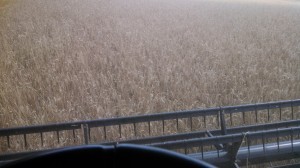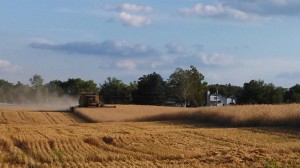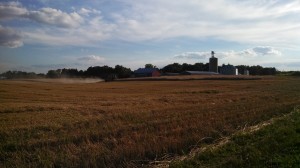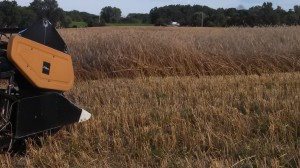We harvested our rye this week. Here’s the view as you drive the combine:

And the view as you watch the combine[1]:

That’s the ‘Home Farm’ in the background of the picture below.

My Great-Grandpa probably stood in that same spot and looked at that same barn.
All that combining results in a big ol’ truck full of rye.

You can see how thick the rye straw is in this picture.

As soon as the sun started going down the straw got tough and we had to stop for the day.
We’re going to use this rye for seed. We’ll broadcast it on our corn and soybean fields this fall to be a cover crop to prevent erosion and build soil quality.
This is just another post on what we’re doing on the farm. But it’s also about about something much more important to me than our day to day business.
We could, of course, have grown corn on this field instead of rye, sold the corn, and bought the rye seed. In fact, it would’ve made economic sense to do so. We could sell the corn, buy the rye seed, and come out with a few bucks in our pockets.
But in doing that, we’d be buying fertilizer, seed, and chemicals to grow the corn at prices we don’t control. The fertilizer, seed, and chemicals we’d buy are produced with fossil fuels we can’t replace. We’d sell the corn at prices we don’t control. We’d buy the rye seed at a price we don’t control. We’d be consumers.
Growing our own rye seed we’re closer to self-sufficiency. We’re less dependent on Monsanto, DuPont, and BASF. We’re not spending our irreplaceable capital of fossil fuel. We’re adding diversity to our farm both in growing the rye and using it as a cover crop, instead of being a corn/soybean monoculture.
It may be seen as quaint by some, and miserly by others. I see it as sensible.
Leave a Reply